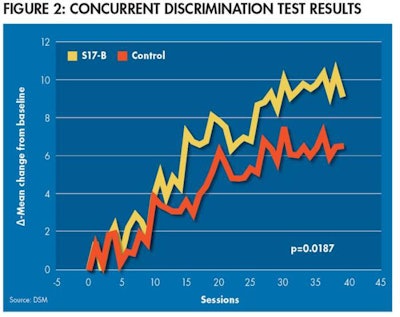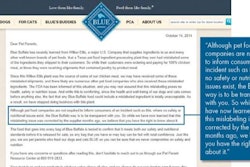
Like humans, dogs are living longer and, therefore, spending longer periods of life in the senior and geriatric lifestages. These older dogs have different nutritional requirements than younger animals, and many require supplementation in their diets to help avoid the onset of certain age-related health issues, such as a decline in cognitive function. Ingredients rich in omega-3 fatty acids, among which fish oil is most common, have been shown to help support the health of aging dogs. Now, new research has shown that a specific marine algae may offer a sustainable and cost-effective alternative to fish oil, which not only supports brain function in older dogs but also provides other nutrients important for maintaining the health of these senior pets.
It is not unusual that with a growing population of older humans and aging dogs, we often see health issues that parallel each other. "The key to unlocking some of nature's most perplexing puzzles in human health has actually stood right next to us, wagging its tail," said Matthew Breen, a genomics professor at North Carolina State University College of Veterinary Medicine. Since nutrition plays an integral role in steering both species’ biological pathways, nutritional supplements that are effective at mediating human health concerns are excellent candidates for addressing the same health concerns in dogs.
Despite the many benefits of consuming a healthy diet, getting adequate nutrition can be a challenge for both humans and dogs. With age, the number of calories required daily begins to decline, and each calorie consumed must be packed with vital nutrients to create a more balanced diet. Popular and fast-growing supplement ingredients in the human market, such as glucosamine, omega fatty acids and probiotics, provide the petfood industry with the opportunity to pursue many of the same dietary supplements in the quest to address the health needs of aging dogs.
An August 2012 Packaged Facts consumer survey showed that 43% of dog owners and 36% of cat owners already purchase some type of specialty nutritional formula petfood or supplemental nutrition products for their pets. "As in [the] human nutritional products market," says David Sprinkle, research director at Packaged Facts, "aging is the core market driver, as more pets suffer from age-related conditions such as joint deterioration and cognitive dysfunction."
Of the nutrient categories, one plays a particularly important role: omega-3 fatty acids. More than 14,000 scientific reports (the majority of which have studied canines) addressed their use to support the health and well-being of companion animals. For example, companies like Hill’s Pet Nutrition and P&G Pet Care have already demonstrated that nutrient supplementation with omega-3 fatty acids like DHA can significantly impact the achievement of genetic potential in puppies, increasing trainability.
Although the underlying physiological reason for the described health benefits of omega-3 fatty acids may be complex, these perceived benefits are at the top of the list for many dog owners, such as skin health and coat condition; brain health, including trainability and the decline of cognitive function; and even heart and vision health. Thus, it is understandable that over the past 10 years, the industry has seen significant growth in both offerings and consumption of pet products that boast health benefits because they contain omega-3 fatty acids. Now, further evidence has demonstrated that supplementation of this nutrient can also help to improve cognitive function in older dogs.
Growth in the older dog population means that a greater number of pet parents are experiencing the strain of having an older dog presenting with a decline in cognitive function. This condition, called Cognitive Dysfunction Syndrome (CDS), can be compared to Alzheimer’s disease in humans.
Researchers believe CDS is caused by physical and chemical changes that affect the brain’s function in older dogs, causing dogs who suffer from the condition to show signs of confusion and/or various other behavioral changes that are not a normal part of aging. In one study at the University of California-Davis, 62%of 11- to 16-year-old dogs showed signs in at least one category of CDS. With the increased humanization of dogs, many pet owners are looking for ways to prevent the onset of this irreversible condition using nutritional intervention
Currently, fish oil is the ingredient most used by the petfood industry as a source of omega-3 fatty acids; however, fish oils can present many challenges. The total omega-3 fatty acid concentration and ratio of the specific fatty acids DHA and EPA are variants of fish oil linked to the source of fish and the extraction, refining and blending processes inherent in the supply chain. Also due to the rising demand for high DHA and EPA fish oils in the human dietary supplement market, the DHA and EPA potency of fish oil available to the pet industry is diminishing. Outside of the inconsistencies in composition there are greater quality concerns with fish oil. The majority of fish oils sold require special purification and deodorization processes to reduce contaminants like heavy metals, PCB, dioxin and antibiotics and those responsible for fishy odors that may adversely affect the quality of the final pet product. Consequently, the greatest challenge going forward for the pet industry is procuring high-quality fish oil as a potent source of EPA and DHA while competing with a rapidly growing human market demand for the same omega-3-rich ingredient.
As a result, in sourcing ingredients that contain fish oil, it is important to understand that fish do not create their own omega-3 fatty acids. The original source of these fatty acids is marine algae (see Figure 1). Fish oil contains DHA and EPA because of the food chain in the ocean. Unless farm-raised fish are fed ocean fish or algae, they do not contain these important omega-3 fatty acids. Fish farmers have been slow to adapt algae as a source of omega-3 because it is typically a low-margin industry, and algae is more expensive than crude ocean fish by-products. Consequently, overfishing our oceans has become a real issue, and crude fish oil prices have spiked 86% since 2011 due to the rising demand.
High-quality, whole-cell marine algae, research has shown, can be a feasible alternative to ocean fish-derived raw materials. Algae grown by fermentation has many positive attributes; it is a rich, highly sustainable source of these desired omega-3 fatty acids, which is void of the contaminants potentially found in fish sources. A high-quality algae that is odor- and color-neutral allows for greater flexibility in the development of petfood products. Plus, the price of this type of algae is also more consistent because it is produced by fermentation, where demand has much less impact on the cost of production.
Although marine micro-algae is a rich source of omega-3 fatty acids, it is relatively new to animal nutrition, and so relatively few studies have been done to demonstrate its effect on the health of companion animals. A recent study by Cancog technologies, which evaluated a new petfood ingredient containing this marine micro-algae, evaluated animals’ ability to visually identify and remember various objects and images using a series of behavioral-based tests over time.
The study, which used a standard commercially available dry dog food made with (test diet) and without (control diet) the added marine algae ingredient, involved feeding two cognitively equivalent groups of 8.5- to 11-year-old dogs over a seven-month period. Over the course of this study, five different behavioral-based tests were performed to measure components of visual performance, learning and memory that, together, describe an individual dog’s cognitive function.
Notably, the potential benefits of marine micro-algae as a substitute for fish oil in supporting brain health came from the concurrent discrimination test (see Figure 2), which measured each dogs’ ability to perform the task correctly over time, and the contrast sensitivity test that measured how successfully each dog visually identified printed geometric images on a white background. In both tests, dogs whose diet contained the marine micro-algae ingredient performed better than dogs fed the control diet, signifying improved learning, visual processing involving the retina and/or cerebral cortex, and long-term memory due to supplementation, according to the researchers.
Leading manufacturers of petfood and nutrition products today are looking for cost-effective, natural ingredients, which deliver health benefits that address the needs of the aging companion animal population and also satisfy the demands of pet parents. Whole-cell, micro-algae has been proven to offer the pet industry a sustainable, natural source of nutritional lipids that support cognitive function in aging dogs, and provide an alternative to fish oil. This unique ingredient also contains protein, dietary fibers, minerals and other nutrients important for a pet’s complete and balanced diet.

















